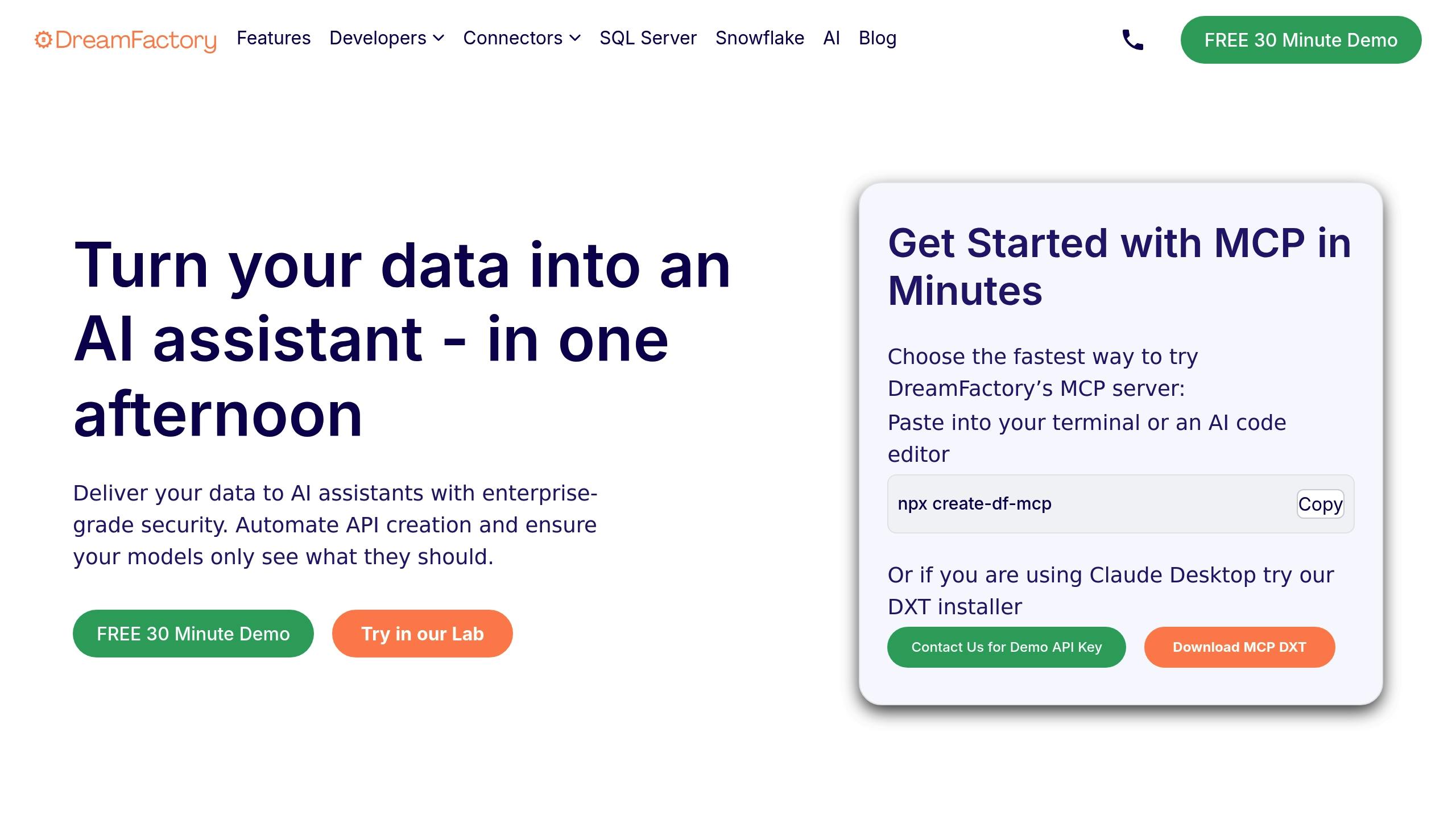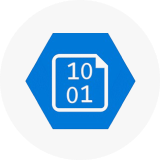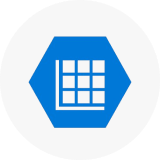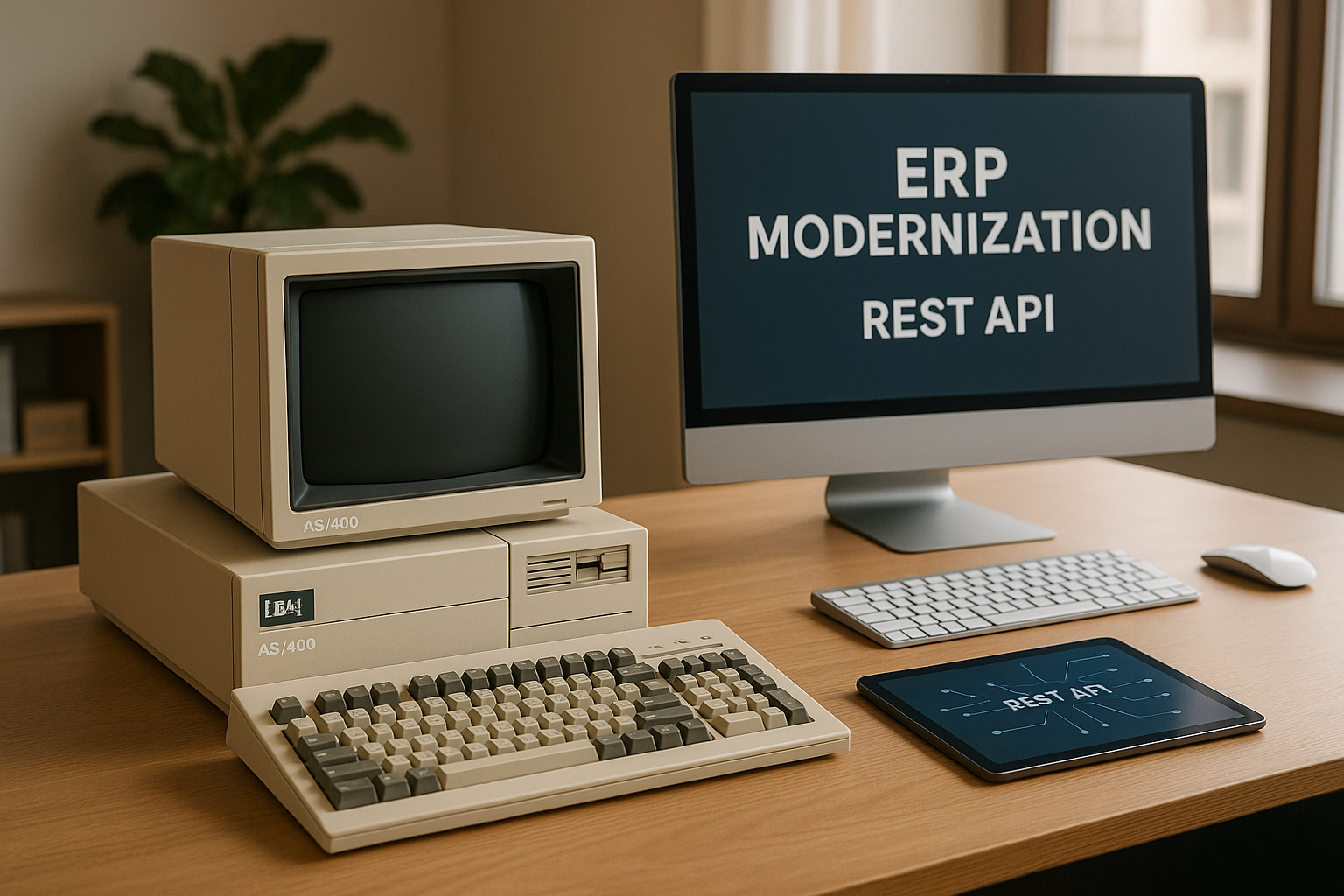Modernizing AS/400 systems and legacy ERP platforms is no longer optional - it’s essential for businesses to stay competitive. These systems, while reliable, struggle to meet modern demands like real-time data access, cloud integration, and mobile compatibility. The solution? REST API generators.
REST API generators allow businesses to connect outdated systems with modern applications without overhauling the entire infrastructure. Here’s why they’re game-changers:
Simplified Integration: Automates API creation, enabling seamless communication between legacy systems and modern platforms.
Real-Time Data: Eliminates batch processing delays, allowing instant data updates.
Cost-Effective: Avoids expensive system rebuilds by modernizing incrementally.
Enhanced Security: Adds modern authentication and access controls to legacy systems.
Scalable: Supports gradual upgrades, ensuring minimal disruption to operations.
Tools like DreamFactory streamline this process with features such as automatic API generation, built-in security, and flexible deployment options. Whether your goal is to improve performance, reduce costs, or meet compliance standards, REST API generators offer a practical path forward.
Key takeaway: Modernization doesn’t have to mean starting over. By leveraging REST API generators, you can extend the life of your AS/400 systems while meeting today’s technological needs.
Key Modernization Strategies for AS/400 and Legacy ERP
Common Modernization Approaches
Modernizing AS/400 and legacy ERP systems can take several paths, each with its own balance of cost, time, risk, and integration potential.
Re-hosting is the simplest route. It involves moving legacy applications to newer hardware or cloud platforms without altering the original code. While this reduces hardware expenses and boosts system reliability, it doesn't fix outdated user interfaces or integration challenges. Essentially, the system remains the same at its core, which can limit compatibility with modern applications.
Re-engineering, on the other hand, completely rebuilds legacy systems using modern technologies. This approach allows businesses to adopt up-to-date development frameworks, cloud capabilities, and improved user experiences. However, it demands a significant investment of time, money, and resources. Projects like these can span months or even years, and there's a risk of losing critical business logic embedded in the original system.
Refactoring strikes a middle ground. Instead of a complete rebuild, it focuses on updating specific components while keeping the system's core functionality intact. For example, businesses might revamp the user interface, enhance database performance, or strengthen security. While refactoring allows for gradual improvements, it may not fully resolve integration issues with newer applications.
API enablement has gained traction as a practical and efficient strategy. Rather than overhauling legacy systems, this method creates modern interfaces that connect external applications to existing AS/400 data and functionality. It preserves the stability of the legacy system while unlocking new opportunities for integration and growth.
|
Approach |
Time to Implement |
Cost |
Risk Level |
Integration Benefits |
|---|---|---|---|---|
|
Re-hosting |
3-6 months |
Low |
Low |
Limited |
|
Refactoring |
6-18 months |
Medium |
Medium |
Moderate |
|
API Enablement |
1-3 months |
Low |
Low |
High |
|
Re-engineering |
12-36 months |
High |
High |
Very High |
Among these options, API enablement stands out for its ability to seamlessly link legacy systems with modern applications.
How REST API Generators Improve Modernization
Expanding on the API enablement strategy, REST API generators simplify and accelerate the process of modernizing legacy systems. These tools automate the creation of modern interfaces, significantly reducing the time and expertise required.
Real-time integration is one of the key benefits. Traditional AS/400 systems often rely on batch processing, where data updates occur at set intervals - sometimes just once a day. REST API generators allow for instant data synchronization, enabling legacy systems to communicate with modern applications in real-time.
Another advantage is the reduction in manual development effort. Custom integration typically demands deep knowledge of both legacy systems and modern development practices. REST API generators handle much of the heavy lifting, including data format conversions, connection management, and error handling. For instance, tools like DreamFactory can automatically generate REST APIs for databases and stored procedures, complete with Swagger documentation to simplify the integration process for developers.
Improved data security is another critical benefit. Legacy systems often lack modern security measures like role-based access control (RBAC), API key management, and OAuth support. REST API generators can introduce these features without requiring changes to the underlying system. DreamFactory, for example, includes built-in security controls such as RBAC and OAuth to ensure secure data access.
Deployment flexibility is another strength of modern REST API generators. They support a range of deployment options, from on-premises setups to cloud-native environments like Kubernetes. This flexibility allows businesses to modernize at their own pace while adhering to existing security policies and compliance requirements.
With server-side scripting, organizations can implement custom business logic without altering the legacy system. Features like data validation, transformation rules, and workflow automation can be added using modern scripting languages such as Python, PHP, or Node.js. This ensures that legacy systems remain intact while still meeting current business needs.
Finally, compliance and regulatory requirements are easier to manage with automated API generation. Many industries demand strict data handling protocols and audit trails. REST API generators can provide robust logging, reporting, and integration with monitoring tools like the ELK stack, ensuring that modernization efforts align with regulatory standards.
REST API Generation: Concepts and Benefits
What is Automated REST API Generation?
Automated REST API generation transforms outdated databases into modern web-friendly endpoints without the need for manual coding. This process examines the structure of existing databases, including schemas, stored procedures, and system frameworks, to create standardized REST endpoints that external applications can easily interact with.
Here’s how it works: the system analyzes the database, identifying tables, relationships, and stored procedures, and then maps them into RESTful resources. For instance, if you have a customer table in an AS/400 system, it could be accessed via standard HTTP methods like GET, POST, PUT, and DELETE at endpoints such as /api/v1/customers.
The generator ensures that legacy database schemas - including keys, relationships, and constraints - are accurately represented. It delivers structured API responses in modern JSON formats while maintaining the original system’s integrity and business logic.
Another key feature is auto-generated documentation, which eliminates much of the guesswork for developers tasked with integrating legacy systems. This documentation provides clear guidance on how to use the newly created APIs.
The setup process is straightforward and requires minimal effort. Administrators simply input database connection details, select the tables or procedures they want to expose, and configure security settings. Within minutes, the generator produces fully functional APIs, drastically reducing the time and effort compared to traditional development methods.
This automated approach not only simplifies integration but also delivers a range of operational benefits, as outlined below.
Main Benefits of REST API Generators
Automated REST API generation provides a host of advantages that go beyond its technical capabilities.
Faster Deployment: One of the standout benefits is speed. Automated tools significantly shorten development timelines, allowing legacy systems to integrate with modern applications much faster. For example, platforms like DreamFactory enable instant REST API generation, accelerating modernization efforts.
Lower Costs: Traditional API development requires specialized developers and extensive coding, which can be expensive. By automating the process, organizations can rely on their existing IT teams and allocate resources to other priorities, reducing overall costs.
Enhanced Security: Built-in security features make protecting legacy systems easier. These include enterprise-grade controls such as role-based access control (RBAC), OAuth 2.0, and API key management - features that would otherwise require significant manual effort to implement.
Improved Scalability and Performance: Modern API generators optimize how API calls are handled, ensuring that legacy systems can manage today’s workloads and usage demands without compromising performance.
Simplified Compliance: Comprehensive logging and reporting features help organizations meet regulatory standards like HIPAA and GDPR. For instance, DreamFactory includes detailed monitoring tools that track data access and system activity, making compliance easier to manage.
Reduced Maintenance Efforts: When database schemas change, automated API generation minimizes the need for manual updates. This reduces the long-term maintenance burden compared to custom-built integrations.
Greater Integration Flexibility: Standardized REST APIs make legacy systems compatible with modern technologies, including mobile apps, cloud platforms, business intelligence tools, and third-party SaaS solutions. This compatibility opens doors to new automation possibilities and advanced data analytics.
Unlimited API Creation: DreamFactory, for example, supports unlimited API generation, allowing organizations to create tailored views of their data for different applications or user groups. This flexibility supports complex enterprise architectures while maintaining high standards of security and performance.
Modernizing AS/400 and Legacy ERP with DreamFactory

DreamFactory Features for Legacy Modernization
DreamFactory provides a seamless way to bring AS/400 and legacy ERP systems into the modern era by transforming database schemas, stored procedures, and system frameworks into web-ready REST endpoints in just minutes.
With support for over 20 connectors - including IBM DB2, SQL Server, MongoDB, and Snowflake - DreamFactory enables organizations to modernize their technology stacks without being limited by database types. This flexibility ensures compatibility across a wide range of systems.
For those dealing with complex legacy integrations, the platform’s server-side scripting capabilities are a game-changer. DreamFactory supports scripting in Python, PHP, NodeJS, and V8JS, allowing IT teams to tailor API behavior, incorporate business logic, and maintain existing workflows during the transition. One standout feature is its ability to convert SOAP services into RESTful APIs, a crucial tool for overcoming the integration hurdles common with AS/400 systems.
The SOAP-to-REST conversion feature is particularly valuable, as many AS/400 systems rely on SOAP web services. By transforming these into REST APIs, DreamFactory bridges the gap between older systems and modern applications, making integration far more accessible.
Additionally, DreamFactory auto-generates Swagger API documentation, which includes detailed endpoint descriptions, parameter specifications, and example requests. This documentation is instantly available once APIs are created, speeding up developer onboarding and simplifying integration tasks.
Deployment flexibility is another strength of the platform. Whether your organization uses Kubernetes, Docker, or traditional Linux environments, DreamFactory can be implemented on-premises or in the cloud. This adaptability ensures it fits seamlessly into your existing infrastructure.
Finally, the platform allows for unlimited API creation and usage, enabling organizations to expose various views of their data to different applications and user groups without worrying about licensing restrictions. These capabilities set the stage for the robust security measures discussed next.
Compliance and Security with DreamFactory
Beyond its modernization tools, DreamFactory prioritizes security and compliance, critical factors when dealing with legacy systems that often contain sensitive business data.
The platform includes enterprise-grade security features to protect your systems. Role-Based Access Control (RBAC) provides detailed permission management, letting administrators define user roles, assign API access levels, and control access to specific database tables or stored procedures. This ensures that modernization efforts do not compromise existing security policies.
DreamFactory also supports API key management and OAuth 2.0, offering multiple authentication methods to suit different applications. Legacy systems that previously relied on database-level security can now adopt modern, token-based authentication with ease.
For organizations subject to regulatory requirements like GDPR or HIPAA, DreamFactory includes features such as robust logging, encryption, and audit trails. API requests, responses, and user activities are meticulously logged, creating the detailed records needed for compliance reporting. Real-time monitoring and historical analysis, powered by the ELK stack, help identify potential security threats, track performance issues, and troubleshoot problems effectively.
Implementation Strategies and Best Practices
Step-by-Step Modernization Process
Updating AS/400 and legacy ERP systems calls for a well-thought-out, gradual approach. Jumping straight to a full system replacement can be risky, often leading to unnecessary expenses and prolonged downtime.
Assessment and Planning Phase
Start by conducting a thorough audit of your systems. Map out all applications, databases, and their dependencies. This is critical because 83% of data migration projects fail or exceed time and budget expectations, according to Gartner research. Use tools like system diagrams and data dictionaries to document how your AS/400 systems interact with other business applications.
Identify high-risk areas - systems with security vulnerabilities, limited expertise to maintain them, or significant downtime costs. A report from the U.S. Government Accountability Office highlights the financial burden of delaying modernization, noting that maintaining 10 outdated federal systems costs $337 million annually. This evaluation will help you focus on a targeted API strategy.
API Strategy Development
Once you’ve mapped your system landscape, the next step is to design your API strategy. Start by exposing critical business data and processes through REST APIs. This allows you to keep current workflows intact while gradually integrating modern solutions.
DreamFactory offers server-side scripting in Python, PHP, NodeJS, and V8JS, which lets you reuse existing business logic during the transition. This flexibility means you don’t have to rewrite complex AS/400 processes all at once. A phased approach like this ensures a smoother rollout.
Phased Implementation
Take a step-by-step approach to modernization. Begin with non-critical functions that don’t disrupt core operations. This minimizes risk and gives your team time to familiarize themselves with the new architecture before tackling essential applications.
During implementation, make sure your security measures align with existing policies while also preparing for modern authentication methods like token-based systems.
Testing and Validation
Before going live, rigorously test each API endpoint. Use detailed documentation to speed up onboarding for developers working with the new APIs.
Performance testing is equally important. Modern systems can improve processing speeds by up to 80%, reducing response times from 5 seconds to under 1 second. Ensure your APIs meet these performance benchmarks before deployment.
Best Practices for Secure and Scalable Modernization
To ensure long-term success, prioritize security and scalability throughout the modernization process.
Security-First Approach and Risk Mitigation
Security should be at the forefront of your strategy. Organizations that adopt modern security frameworks report 92% faster threat detection and 85% quicker patching. Use DreamFactory’s ELK stack integration for comprehensive logging and monitoring, creating audit trails that simplify compliance reporting. This is crucial, as 92% of organizations cite regulatory compliance as a key driver for updating legacy systems.
Establish robust backup and rollback procedures for each phase. With ransomware incidents costing an average of $1.85 million to resolve, having a solid security and backup plan is non-negotiable.
Keep parallel systems running during critical transition periods. While resource-intensive, this ensures uninterrupted operations and reduces risk.
Stakeholder Engagement and Training
Involve stakeholders early and provide training on the new systems. This minimizes resistance and ensures smoother adoption. Technical teams need to learn API management and modern development practices, while business users should become familiar with updated interfaces and workflows.
Performance and Scalability Planning
Design your API architecture to scale with your business. DreamFactory supports deployment across Kubernetes, Docker, and traditional Linux environments, giving you the flexibility to adjust as demand grows. Implement caching strategies and load balancing from the start to handle increased workloads efficiently.
Continuously monitor API usage and performance metrics. This helps you identify bottlenecks early and plan for future scaling needs.
Cost Management
Keep a close eye on costs and weigh them against the benefits of modernization. With 65% of businesses spending over $2 million annually on maintaining legacy systems, the financial case for modernization is clear. A well-executed strategy can significantly reduce these ongoing expenses while improving operational efficiency.
Conclusion and Next Steps
Key Takeaways from Legacy ERP Modernization
Modernizing AS/400 and other legacy ERP systems can reshape how businesses operate by cutting costs and improving performance. Holding off on this transformation often leads to escalating maintenance expenses, while modernization offers measurable advantages.
One effective approach is using REST API generators to upgrade legacy systems. This method retains existing business logic while integrating modern functionalities. The result? Enhanced security, better performance, and increased efficiency - all with minimal risk and downtime.
DreamFactory's platform tackles the core hurdles of legacy modernization. It offers instant API generation, built-in security measures, and flexible deployment options. Plus, its compliance with GDPR and HIPAA ensures that your modernization efforts align with regulatory standards from the start.
Adopting modern API architectures doesn’t just save money - it opens doors to new revenue opportunities, enhances customer experiences, and sets the stage for leveraging advanced technologies like artificial intelligence and machine learning.
Getting Started with DreamFactory
Modernizing your systems doesn’t have to interrupt your business operations. DreamFactory offers free trials and demos, letting you test its capabilities with your current systems before making a commitment.
The first step is to outline clear goals for your modernization efforts. Are you aiming to meet regulatory requirements, boost performance, or add new features? Defining these objectives upfront will help shape your strategy. Also, plan your budget to include software, infrastructure, training, and external support.
A phased approach works best. Begin with less critical components to fine-tune the process without affecting key operations. DreamFactory allows you to break down your legacy system into modular components, exposing each as APIs. This makes it easier to integrate old and new systems during the transition.
Before rolling out changes on a larger scale, pilot each module to identify and address any issues early. DreamFactory simplifies this process with automation tools for API generation and management, while continuous testing ensures that each module meets your business needs and performance benchmarks.
Don’t overlook the importance of change management and training. Start by assessing your team’s skills to identify gaps, then create tailored training programs. Open communication about the benefits of modernization will help build organizational support and ensure a smoother transition.
With careful planning and a step-by-step implementation strategy, DreamFactory equips you with the tools and flexibility to modernize your legacy systems. By transitioning to an API-driven architecture, your organization will be well-prepared for growth and future innovation. This is your starting point for a seamless modernization journey.
IBM i API Strategy: Complete Guide to REST APIs, JSON Integration & Open Source Development
FAQs
What are the key advantages of using REST API generators to modernize AS/400 and legacy ERP systems?
REST API generators make it easier to connect older systems, like AS/400, with modern applications. They automate the creation of APIs, which streamlines data sharing and integration. This means businesses can modernize outdated workflows, cut down on maintenance costs, and keep their existing systems running longer - all without needing a complete overhaul.
By using REST APIs, companies can improve performance, security, and adaptability, ensuring their IT infrastructure keeps up with today’s business needs. It’s a practical way to upgrade systems without major disruptions, offering a smoother and more budget-friendly path to a flexible, future-ready setup.
How does API enablement compare to other legacy system modernization methods like re-hosting or re-engineering?
API enablement offers a smart way to modernize legacy systems by connecting them with newer applications through REST APIs. This method stands out because it allows businesses to enhance system compatibility and adaptability without the need for major overhauls or migrations.
Unlike re-hosting, which simply shifts systems to the cloud with minimal adjustments, API enablement makes it possible to tap into existing functionalities and use them in modern digital setups. This approach not only cuts down on costs but also simplifies the process. On the other hand, compared to re-engineering - which often requires time-intensive redevelopment - API enablement is quicker, allows for gradual updates, and aligns more effectively with the fast-changing demands of today's business landscape.
What security measures do REST API generators offer to protect legacy system integrations?
REST API generators, such as DreamFactory, come equipped with robust security measures to protect legacy system integrations. Key features include role-based access control (RBAC), API key management, and multi-factor authentication (MFA), all designed to ensure that only authorized users can access your APIs.
Additionally, they implement encryption for data both in transit and at rest using trusted TLS protocols. Combined with tokenization, these tools secure sensitive information, safeguard data integrity, and minimize the chances of breaches during legacy system integrations.
Terence Bennett, CEO of DreamFactory, has a wealth of experience in government IT systems and Google Cloud. His impressive background includes being a former U.S. Navy Intelligence Officer and a former member of Google's Red Team. Prior to becoming CEO, he served as COO at DreamFactory Software.
























 Blog
Blog



